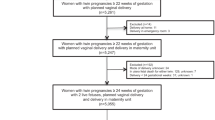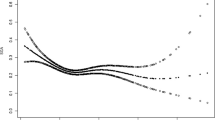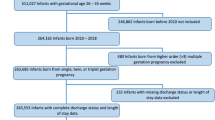Abstract
Objective
To examine the association between pre-pregnancy BMI and severe maternal morbidity (SMM), perinatal death and severe neonatal morbidity in twin pregnancies.
Methods
All twin births at ≥ 20 weeks gestation in British Columbia, Canada, from 2000 to 2017 were included. We estimated rates of SMM, a perinatal composite of death and severe morbidity, and its components per 10,000 pregnancies. Confounder-adjusted rate ratios (aRR) between pre-pregnancy BMI and outcomes were estimated using robust Poisson regression.
Results
Overall, 7770 (368 underweight, 1704 overweight, and 1016 obese) women with twin pregnancy were included. The rates of SMM were: 271.1, 320.4, 270.0, and 225.9 in underweight, normal BMI, overweight and obese women, respectively. There was little association between obesity and any of the primary outcomes (e.g., aRR = 1.09, 95% CI = 0.85, 1.38 for composite perinatal outcome). Underweight women had higher rates of the composite perinatal adverse outcome (aRR = 1.79, 95% CI = 1.32–2.43), driven by increased rates of severe respiratory distress syndrome, and neonatal death.
Conclusions
There was no evidence of elevated risk of adverse outcomes among twin pregnancies of women who were overweight or obese. Risk was higher in underweight women, who may require specific care when carrying twins.
This is a preview of subscription content, access via your institution
Access options
Subscribe to this journal
Receive 12 print issues and online access
$259.00 per year
only $21.58 per issue
Buy this article
- Purchase on Springer Link
- Instant access to full article PDF
Prices may be subject to local taxes which are calculated during checkout

Similar content being viewed by others
Data availability
Access to data provided by the Data Steward(s) is subject to approval but can be requested for research projects through the Data Steward(s) or their designated service providers. All inferences, opinions, and conclusions drawn in this publication are those of the author(s), and do not reflect the opinions or policies of the Data Steward(s).
References
Chen C, Xu X, Yan Y. Estimated global overweight and obesity burden in pregnant women based on panel data model. PLoS ONE 2018;13. https://doi.org/10.1371/journal.pone.0202183.
Driscoll AK. Increases in Prepregnancy Obesity: United States, 2016–2019. 2020;392:1–8.
Devlieger R, Benhalima K, Damm P, Van Assche A, Mathieu C, Mahmood T, et al. Maternal obesity in Europe: Where do we stand and how to move forward?: A scientific paper commissioned by the European Board and College of Obstetrics and Gynaecology (EBCOG). Eur J Obstet Gynecol Reprod Biol. 2016;201:203–8.
Heslehurst N, Rankin J, Wilkinson JR, Summerbell CD. A nationally representative study of maternal obesity in England, UK: Trends in incidence and demographic inequalities in 619 323 births, 1989–2007. Int J Obes. 2010;34:420–8.
Lisonkova S, Muraca GM, Potts J, Liauw J, Chan W-S, Skoll A, et al. Association between prepregnancy body mass index and severe maternal morbidity. JAMA. 2017;318:1777–86.
Aune D, Saugstad OD, Henriksen T, Tonstad S. Maternal body mass index and the risk of fetal death, stillbirth, and infant death: A systematic review and meta-analysis. JAMA. 2014;311:1536–46.
Chu SY, Kim SY, Lau J, Schmid CH, Dietz PM, Callaghan WM, et al. Maternal obesity and risk of stillbirth: A metaanalysis. Am J Obstet Gynecol. 2007;197:223–8.
Cheong-See F, Schuit E, Arroyo-Manzano D, Khalil A, Barrett J, Joseph KS, et al. Prospective risk of stillbirth and neonatal complications in twin pregnancies: Systematic review and meta-analysis. BMJ. 2016;354:i4353.
Madar H, Goffinet F, Seco A, Rozenberg P, Dupont C, Deneux-Tharaux C. Severe acute maternal morbidity in twin compared with singleton pregnancies. Obstet Gynecol. 2019;133:1141–50.
Chauhan SP, Scardo JA, Hayes E, Abuhamad AZ, Berghella V. Twins: Prevalence, problems, and preterm births. Am J Obstet Gynecol. 2010;203:305–15.
Ram M, Berger H, Lipworth H, Geary M, McDonald SD, Murray-Davis B, et al. The relationship between maternal body mass index and pregnancy outcomes in twin compared with singleton pregnancies. Int J Obes. 2020;44:33–44.
Al-Obaidly S, Parrish J, Murphy KE, Maxwell C. Maternal pre-gravid body mass index and obstetric outcomes in twin gestations. J Perinatol. 2014;34:425–8.
Perinatal Services BC. British Columbia Perinatal Data Registry. Years Provided: (2000 to 2017). Resource Type: Data Extract. Data Provided on (2020).
Frosst G, Hutcheon J, Joseph K, Kinniburgh B, Johnson C, Lee L. Validating the British Columbia perinatal data registry: A chart re-abstraction study. BMC Preg Childbirth 2015;15. https://doi.org/10.1186/s12884-015-0563-7.
Dzakpasu S, Deb-Rinker P, Arbour L, Darling EK, Kramer MS, Liu S, et al. Severe maternal morbidity surveillance: Monitoring pregnant women at high risk for prolonged hospitalisation and death. Paediatr Perinat Epidemiol. 2020;34:427–39.
Greenland S, Pearce N. Statistical foundations for model-based adjustments. Annu Rev Public Health. 2015;36:89–108.
Greenland S. Interval estimation by simulation as an alternative to and extension of confidence intervals. Int J Epidemiol. 2004;33:1389–97.
Targeted Learning - Causal Inference for Observational and Experimental Data | Mark J. van der Laan | Springer. https://www.springer.com/gp/book/9781441997814 (accessed 12 Apr 2021).
Balzer LB, Zheng W, van der Laan MJ, Petersen ML. A new approach to hierarchical data analysis: Targeted maximum likelihood estimation for the causal effect of a cluster-level exposure. Stat Methods Med Res. 2019;28:1761–80.
Benkeser D, Carone M, Laan MJVD, Gilbert PB. Doubly robust nonparametric inference on the average treatment effect. Biometrika. 2017;104:863–80.
VanderWeele TJ, Ding P. Sensitivity analysis in observational research: Introducing the E-value. Ann Intern Med. 2017;167:268–74.
Bone JN, Joseph KS, Mayer C, Platt R, Lisonkova S. The association between pre-pregnancy body mass index and perinatal death and the role of gestational age at delivery. PLOS ONE. 2022;17:e0264565.
Fox NS, Roman AS, Saltzman DH, Klauser CK, Rebarber A. Obesity and adverse pregnancy outcomes in twin pregnancies. J Matern-Fetal Neonatal Med Off J Eur Assoc Perinat Med Fed Asia Ocean Perinat Soc Int Soc Perinat Obstet. 2014;27:355–9.
Lucovnik M, Blickstein I, Verdenik I, Trojner-Bregar A, Tul N. Maternal obesity in singleton versus twin gestations: A population-based matched case–control study. J Matern Fetal Neonatal Med. 2015;28:623–5.
Lučovnik M, Tul N, Verdenik I, Novak Z, Blickstein I. Risk factors for preeclampsia in twin pregnancies: A population-based matched case-control study. J Perinat Med. 2012;40:379–82.
Simões T, Queirós A, Correia L, Rocha T, Dias E, Blickstein I. Gestational diabetes mellitus complicating twin pregnancies. 2011;39:437–40.
Suzuki S, Yoneyama Y, Sawa R, Shin S, Araki T. Clinical usefulness of maternal body mass index in twin pregnancies. Hypertens Pregnancy. 2000;19:273–9.
Salihu HM, Alio AP, Belogolovkin V, Aliyu MH, Wilson RE, Reddy UM, et al. Prepregnancy obesity and risk of stillbirth in viable twin gestations. Obesity. 2010;18:1795–1800.
Yao R, Ananth CV, Park BY, Pereira L, Plante LA. Obesity and the risk of stillbirth: A population-based cohort study. Am J Obstet Gynecol. 2014;210:457.e1–457.e9.
Lu GC, Rouse DJ, DuBard M, Cliver S, Kimberlin D, Hauth JC. The effect of the increasing prevalence of maternal obesity on perinatal morbidity. Am J Obstet Gynecol. 2001;185:845–9.
Scott G, Gillon TE, Pels A, Dadelszen P von, Magee LA. Guidelines—similarities and dissimilarities: a systematic review of international clinical practice guidelines for pregnancy hypertension. Am J Obstet Gynecol. 2020;0. https://doi.org/10.1016/j.ajog.2020.08.018.
Kristensen J, Vestergaard M, Wisborg K, Kesmodel U, Secher NJ. Pre-pregnancy weight and the risk of stillbirth and neonatal death. BJOG Int J Obstet Gynaecol. 2005;112:403–8.
Marleen S, Dias C, Nandasena R, MacGregor R, Allotey J, Aquilina J, et al. Association between chorionicity and preterm birth in twin pregnancies: A systematic review involving 29 864 twin pregnancies. BJOG Int J Obstet Gynaecol. 2021;128:788–96.
Salihu HM, Dunlop A-L, Hedayatzadeh M, Alio AP, Kirby RS, Alexander GR. Extreme obesity and risk of stillbirth among black and white gravidas. Obstet Gynecol. 2007;110:552–7.
Pasquali R, Patton L, Gambineri A. Obesity and infertility. Curr Opin Endocrinol Diabetes Obes. 2007;14:482–7.
Lisonkova S, Joseph KS. Left truncation bias as a potential explanation for the protective effect of smoking on preeclampsia. Epidemiol Camb Mass. 2015;26:436–40.
Sapra KJ, Chaurasia AK, Hutcheon JA, Ahrens KA. Reconstructing a pregnancy cohort to examine potential selection bias in studies on racial disparities in preterm delivery. Paediatr Perinat Epidemiol. 2017;31:55–63.
Hernan MA, Robins J. Causal Inference: What if. Boca Raton: Chapman & Hill/CRC. 2020.
Lisonkova S, Joseph KS, Bell R, Glinianaia SV. Effect of advanced maternal age on perinatal outcomes in twins: The impact of chorionicity. Ann Epidemiol. 2013;23:428–34.
Sung SJ, Lee SM, Kim S, Kim BJ, Park C-W, Park JS, et al. The risk of spontaneous preterm birth according to maternal pre-pregnancy body mass index in twin gestations. J Korean Med Sci. 2018; 33. https://doi.org/10.3346/jkms.2018.33.e103.
Gete DG, Waller M, Mishra GD. Effects of maternal diets on preterm birth and low birth weight: A systematic review. Br J Nutr. 2020;123:446–61.
Smith C, Teng F, Branch E, Chu S, Joseph KS. Maternal and perinatal morbidity and mortality associated with anemia in pregnancy. Obstet Gynecol. 2019;134:1234–44.
Jung J, Rahman MM, Rahman MS, Swe KT, Islam MR, Rahman MO, et al. Effects of hemoglobin levels during pregnancy on adverse maternal and infant outcomes: A systematic review and meta-analysis. Ann N Y Acad Sci. 2019;1450:69–82.
Ante Z, Luu TM, Healy-Profitós J, He S, Taddeo D, Lo E, et al. Pregnancy outcomes in women with anorexia nervosa. Int J Eat Disord. 2020;53:403–12.
Yu Y-H, Bodnar LM, Brooks MM, Himes KP, Naimi AI. Comparison of parametric and nonparametric estimators for the association between incident prepregnancy obesity and stillbirth in a population-based cohort study. Am J Epidemiol. 2019;188:1328–36.
Acknowledgements
The authors would like to thank Dr. Cande Anath for his thoughtful feedback on a previous version of this manuscript.
Funding
This study was supported by funding from the Sick Kids Foundations (grant number SKF-154852). JB is supported by a four-year PhD fellowship award from the University of British Columbia (award number 6456). KSJ is supported by an Investigator award from the BC Children’s Hospital Research Institute. SL is supported by a scholar award from the Michael Smith Foundation for Health Research. The funders had no role in study design, data collection and analysis, decision to publish, or preparation of the manuscript. All inferences, opinions and conclusions drawn in this paper are those of the authors and do not reflect the opinions or policies of the Data Stewards.
Author information
Authors and Affiliations
Contributions
SL and JB designed the study and formulated the research question. JB analyzed the data and wrote the first draft of the manuscript with supervision from SL. KS, LAM, LW, and CM read and reviewed the manuscript and provided critical feedback and suggested additional analyses. All authors approved the final version.
Corresponding author
Ethics declarations
Competing interests
The authors declare no competing interests.
Ethical approval
Ethics approval for this study was obtained from the University of British Columbia - Children’s and Women’s Hospital and Health Centre of British Columbia Research Ethics Board (H18–03154).
Additional information
Publisher’s note Springer Nature remains neutral with regard to jurisdictional claims in published maps and institutional affiliations.
Supplementary information
Rights and permissions
Springer Nature or its licensor (e.g. a society or other partner) holds exclusive rights to this article under a publishing agreement with the author(s) or other rightsholder(s); author self-archiving of the accepted manuscript version of this article is solely governed by the terms of such publishing agreement and applicable law.
About this article
Cite this article
Bone, J.N., Joseph, K.S., Magee, L.A. et al. Pre-pregnancy body mass index and adverse maternal and perinatal outcomes in twins: A population retrospective cohort study. Int J Obes 47, 799–806 (2023). https://doi.org/10.1038/s41366-023-01320-6
Received:
Revised:
Accepted:
Published:
Issue Date:
DOI: https://doi.org/10.1038/s41366-023-01320-6



